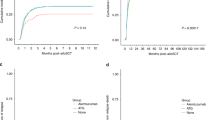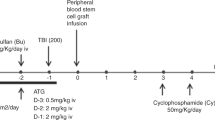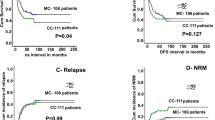Abstract
Application of G-CSF in AML is controversial as leukemic blasts may express receptors interacting with the cytokine, which may stimulate leukemia growth. We retrospectively analyzed the impact of G-CSF use to accelerate neutrophil recovery after auto-SCT on outcome. Adults with AML in first CR autografted between 1994 and 2010 were included. Nine hundred and seventy two patients were treated with G-CSF after auto-SCT whereas 1121 were not. BM and PB were used as a source of stem cells in 454 (22%) and 1639 (78%) cases, respectively. The incidence of relapse at 5 years in the BM-auto-SCT group was 38% for patients receiving post-transplant G-CSF and 43% for those not treated with G-CSF, P=0.46. In the PB-auto-SCT cohort, respective probabilities were 48% and 49%, P=0.49. No impact of the use of G-CSF could be demonstrated with respect to the probability of leukemia-free survival: in the BM-auto-SCT group, 51% for G-CSF(+) and 48% for G-CSF(−), P=0.73; in PB-auto-SCT group, 42% for G-CSF(+) and 43% for G-CSF(−), P=0.83. Although G-CSF administration significantly shortened the neutropenic phase, no beneficial effect was observed with regard to non-relapse mortality. In patients with AML, the use of G-CSF after auto-SCT is not associated with increased risk of relapse irrespective of the source of stem cells used.
This is a preview of subscription content, access via your institution
Access options
Subscribe to this journal
Receive 12 print issues and online access
$259.00 per year
only $21.58 per issue
Buy this article
- Purchase on Springer Link
- Instant access to full article PDF
Prices may be subject to local taxes which are calculated during checkout

Similar content being viewed by others
References
Smith TJ, Khatcheressian J, Lyman GH, Ozer H, Armitage JO, Balducci L et al. 2006 update of recommendations for the use of white blood cell growth factors: an evidence-based clinical practice guideline. J Clin Oncol 2006; 24: 3187–3205.
Breems DA, Löwenberg B . Acute myeloid leukemia and the position of autologous stem cell transplantation. Semin Hematol 2007; 44: 259–266.
Seshadri T, Keating A . Is there a role for autotransplants in AML in first remission? Biol Blood Marrow Transplant 2009; 15: 17–20.
Passweg JR, Baldomero H, Gratwohl A, Bregni M, Cesaro S, Dreger P et al. The EBMT activity survey: 1990-2010. Bone Marrow Transplant 2012; 47: 906–923.
Brenner MK, Rill DR, Moen RC, Krance RA, Mirro J Jr, Anderson WF et al. Gene-marking to trace origin of relapse after autologous bone-marrow transplantation. Lancet 1993; 341: 85–86.
Feller N, Schuurhuis GJ, van der Pol MA, Westra G, Weijers GW, van Stijn A et al. High percentage of CD34-positive cells in autologous AML peripheral blood stem cell products reflects inadequate in vivo purging and low chemotherapeutic toxicity in a subgroup of patients with poor clinical outcome. Leukemia 2003; 17: 68–75.
Vellenga E, Young DC, Wagner K, Wiper D, Ostapovicz D, Griffin JD . The effects of GM-CSF and G-CSF in promoting growth of clonogenic cells in acute myeloblastic leukemia. Blood 1987; 69: 1771–1776.
Löwenberg B, Touw IP . Hematopoietic growth factors and their receptors in acute leukemia. Blood 1993; 81: 281–292.
Gooley TA, Leisenring W, Crowley JA, Storer BE . Estimation of failure probabilities in the presence of competing risks: new representations of old estimators. Stat Med 1999; 18: 665–706.
Fine JP, Gray RJ . A proportional hazards model for subdistribution of a competing risk. J Am Stat Assoc 1999; 94: 496–509.
Gorin NC, Labopin M, Blaise D, Reiffers J, Meloni G, Michallet M et al. Higher incidence of relapse with peripheral blood rather than marrow as a source of stem cells in adults with acute myelocytic leukemia autografted during the first remission. J Clin Oncol 2009; 27: 3987–3993.
Graf M, Hecht K, Reif S, Pelka-Fleischer R, Pfister K, Schmetzer H . Expression and prognostic value of hemopoietic cytokine receptors in acute myeloid leukemia (AML): implications for future therapeutical strategies. Eur J Haematol 2004; 72: 89–106.
Majhail NS, Bajorunaite R, Lazarus HM, Wang Z, Klein JP, Zhang MJ et al. High probability of long-term survival in 2-year survivors of autologous hematopoietic cell transplantation for AML in first or second CR. Bone Marrow Transplant 2011; 46: 385–392.
Heil G, Hoelzer D, Sanz MA, Lechner K, Liu Yin JA, Papa G et al. A randomized, double-blind, placebo-controlled, phase III study of filgrastim in remission induction and consolidation therapy for adults with de novo acute myeloid leukemia. The International Acute Myeloid Leukemia Study Group. Blood 1997; 90: 4710–4718.
Godwin JE, Kopecky KJ, Head DR, Willman CL, Leith CP, Hynes HE et al. A double-blind placebo-controlled trial of granulocyte colony-stimulating factor in elderly patients with previously untreated acute myeloid leukemia: a Southwest oncology group study (9031). Blood 1998; 91: 3607–3615.
Usuki K, Urabe A, Masaoka T, Ohno R, Mizoguchi H, Hamajima N et al. Efficacy of granulocyte colony-stimulating factor in the treatment of acute myelogenous leukaemia: a multicentre randomized study. Br J Haematol 2002; 116: 103–112.
Alonzo TA, Kobrinsky NL, Aledo A, Lange BJ, Buxton AB, Woods WG . Impact of granulocyte colony-stimulating factor use during induction for acute myelogenous leukemia in children: a report from the Children’s Cancer Group. J Pediatr Hematol Oncol 2002; 24: 627–635.
Kutlay S, Beksac M, Dalva K, Ilhan O, Koc H, Akan H et al. The detection of flow cytometric G-CSF receptor expression and it’s effect on therapy in acute myeloid leukemia. Leuk Lymphoma 2003; 44: 791–795.
Wheatley K, Goldstone AH, Littlewood T, Hunter A, Burnett AK . Randomized placebo-controlled trial of granulocyte colony stimulating factor (G-CSF) as supportive care after induction chemotherapy in adult patients with acute myeloid leukaemia: a study of the United Kingdom Medical Research Council Adult Leukaemia Working Party. Br J Haematol 2009; 146: 54–63.
Beksac M, Ali R, Ozcelik T, Ozcan M, Ozcebe O, Bayik M et al. Short and long term effects of granulocyte colony-stimulating factor during induction therapy in acute myeloid leukemia patients younger than 65: results of a randomized multicenter phase III trial. Leuk Res 2011; 35: 340–345.
Gurion R, Belnik-Plitman Y, Gafter-Gvili A, Paul M, Vidal L, Ben-Bassat I et al. Colony-stimulating factors for prevention and treatment of infectious complications in patients with acute myelogenous leukemia. Cochrane Database Syst Rev 2011; 7: CD008238.
Creutzig U, Zimmermann M, Lehrnbecher T, Graf N, Hermann J, Niemeyer CM et al. Less toxicity by optimizing chemotherapy, but not by addition of granulocyte colony-stimulating factor in children and adolescents with acute myeloid leukemia: results of AML-BFM 98. J Clin Oncol 2006; 24: 4499–4506.
Ehlers S, Herbst C, Zimmermann M, Scharn N, Germeshausen M, von Neuhoff N et al. Granulocyte colony-stimulating factor (G-CSF) treatment of childhood acute myeloid leukemias that overexpress the differentiation-defective G-CSF receptor isoform IV is associated with a higher incidence of relapse. J Clin Oncol 2010; 28: 2591–2597.
White SM, Ball ED, Ehmann WC, Rao AS, Tweardy DJ . Increased expression of the differentiation-defective granulocyte colony-stimulating factor receptor mRNA isoform in acute myelogenous leukemia. Leukemia 1998; 12: 899–906.
Beekman R, Touw IP . G-CSF and its receptor in myeloid malignancy. Blood 2010; 115: 5131–5136.
Stahel RA, Jost LM, Cerny T, Pichert G, Honegger H, Tobler A et al. Randomized study of recombinant human granulocyte colony-stimulating factor after high-dose chemotherapy and autologous bone marrow transplantation for high-risk lymphoid malignancies. J Clin Oncol 1994; 12: 1931–1938.
Linch DC, Milligan DW, Winfield DA, Kelsey SM, Johnson SA, Littlewood TJ et al. G-CSF after peripheral blood stem cell transplantation in lymphoma patients significantly accelerated neutrophil recovery and shortened time in hospital: results of a randomized BNLI trial. Br J Haematol 1997; 99: 933–938.
Schmitz N, Ljungman P, Cordonnier C, Kempf C, Linkesch W, Alegre A et al. Lenograstim after autologous peripheral blood progenitor cell transplantation: results of a double-blind, randomized trial. Bone Marrow Transplant 2004; 34: 955–962.
Dekker A, Bulley S, Beyene J, Dupuis LL, Doyle JJ, Sung L . Meta-analysis of randomized controlled trials of prophylactic granulocyte colony-stimulating factor and granulocyte-macrophage colony-stimulating factor after autologous and allogeneic stem cell transplantation. J Clin Oncol 2006; 24: 5207–5215.
Author information
Authors and Affiliations
Corresponding author
Ethics declarations
Competing interests
The authors declare no conflict of interest.
Rights and permissions
About this article
Cite this article
Czerw, T., Labopin, M., Gorin, NC. et al. Use of G-CSF to hasten neutrophil recovery after auto-SCT for AML is not associated with increased relapse incidence: a report from the Acute Leukemia Working Party of the EBMT. Bone Marrow Transplant 49, 950–954 (2014). https://doi.org/10.1038/bmt.2014.64
Received:
Revised:
Accepted:
Published:
Issue Date:
DOI: https://doi.org/10.1038/bmt.2014.64
This article is cited by
-
Autologous stem cell transplantation for adult acute leukemia in 2015: time to rethink? Present status and future prospects
Bone Marrow Transplantation (2015)



